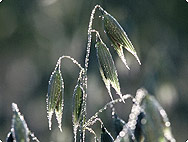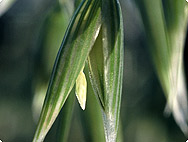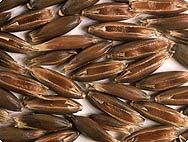A.Vogel search
When the internal search is activated, personal data such as your IP address is transmitted to our search engine Cludo. Data is thus transferred to a third country. Please click here if you want to display the internal search. You can find more information on data protection here: Privacy policy.
A.Vogel plant encyclopaedia
Avena sativa L.
Oats
History

The Ancient Greeks and Romans had scant regard for oats, probably because they were only familiar with wild oats, Avena fatua, which was considered no more than a weed in grain fields. Deliberate cultivation of the grain probably in the Caspian and Caucasian plains or in the bordering plains of Turkmenistan brought oats to north-west Europe during pre-historic times. The Romans first came across oats north of the Alps and called them “the barbaric bread grain of the Germans”. Pliny reports the Germans as sowing oats and eating nothing but gruel. He believed that oats were nothing but a weed among cereals which could only lead to the degeneration of barley. Even today, oats are used in southern climes primarily as fodder for livestock.
The meaning of the word Avena, which the Romans used to refer to both cultivated oats as well as wild oats, has not been established. It could well be that the word is derived from either the Sanskrit word “avi”, meaning “sheep” or “avàsa”, meaning “foodstuff”. Grimm has ascertained that in almost every European language the word for oats has something to do with the word for ram. For this reason, oats acquired the name “goat fodder”.
Oats were not of any importance to ancient naturopaths and it was not until the Middle Ages that oats were to achieve due recognition. Gradually, naturopaths learned more about the plant’s applications and its range of uses broadened considerably. In his herbal encyclopaedia of 1737, Lonicerus writes: “Oats are a useful grain for both cattle and man. Cooked and eaten it is an excellent medication encouraging one’s daily stool; it fills the belly and is a fortifying source of nutrition. Its particular virtue lies in penetrating the damp and consuming hardened ulcers; the flour of oats may be used as a poultice. It is exceedingly good for fistula. It may be consumed warm as a meal but used as a medica¬tion externally it should be cool and dry. Oats are good when used for all manner of swellings and pustules on the body that occur from heat. Wild oats, the stem, seeds and leaves steeped in red wine and drunk soothes both red and white effluvia from the belly and increases the function of the urethra, taking with it all refuse which hath collected in the bladder and womb“.
In 1563 Mathiolus wrote: “The effect of oats: the broth from the steeping of oats is good against coughs. Boiled and eaten, the gruel plugs stool. Against gall stones the common man is wont to heat oats or juniper berries and to place them in a poultice. Oats may be used on swollen or dislocated limbs, just as barley flour. Mixed with white lead and used to wash the countenance it makes a clear, attractive complexion. Against the mange and scabs of small children there is nothing better than to bathe them in steeped oats.”
For centuries, boiled oats or porridge were the staple breakfast, particularly in England, Scotland and Germany, before it was substituted by coffee and bread.
Botanical characteristics

Oats are an annual grass growing either in tufts or in single stalks. The high-growing, hollow stems grow to a height of between 20 and 150 cm and do not branch out. The striate sheaves are open to the ground and the 3-20 mm wide, largely flat blades are rolled at the axil. The panicle stands upright, loose and fans out with fine side branches which barely branch out. The 15-30 cm tall panicles usually bear two- or three-flowered ears. The flowers are androgynous, as are most types of cereal grain. The integuments of the upper or of both flowers are unawned. When the grass is ripe the ears are pendulous. The grains of corn are single-seeded caryopses, the pericarp of which either remains fused to the seed coat or husk or, when ripe, quits the husk and falls naked (as in the Naked Oat). Oats are the airiest, most light-loving of indigenous cereal grains.
The grass blooms from July to August.
Habitat

Oat is a ruderal, which means it flourishes on nitrogen-rich tips and rubbish dumps as well as roadsides from plains up to mountainous areas. It is a secondary cultivated plant which first appears as an unwanted by-plant to other types of cereal grain. Unlike barley, oat needs a great deal of precipitation. The plant’s lushness means that it makes ideal fresh fodder for livestock since it is both grass and corn at the same time. Wild mustard, which often occurs in oat fields, helps to de-acidify the soil, which becomes highly acidic as a result of the oat crop. Tests reveal that oats cultivated in a weed-free environment are less robust than those grown with wild mustard.
Barley is indigenous to dry Mediterranean countries, whereas oats are indigenous to cooler climates where there is heavy rainfall. It is also at home in northerly mountainous countries where there is plenty of daylight and days are long. Nowadays, oats are cultivated almost all over the world in areas where there is substantial rainfall and a temperate climate. An oat crop will yield a greater amount of corn and grass than that of barley or rye.
Preparation

A.Vogel/Bioforce makes use of the parts of the plant which are above ground (herbs, lat. herba), from organically controlled crops. The plants are harvested when in bloom. The oats are chopped up into small pieces while still fresh and placed in alcohol to macerate into a mother tincture. To manufacture a homeopathic dilution, this mother tincture is potentised by hand to various degrees of dilution.
Oatmeal, oat flakes and groats are all highly nutritious and are a valuable source of food. In the food industry, oatmeal is used as a stabiliser in, for example, ice cream; in the cosmetic industry it is used in various skin care products. Oats are also used as fodder for livestock and in the manufacture of ethylene.